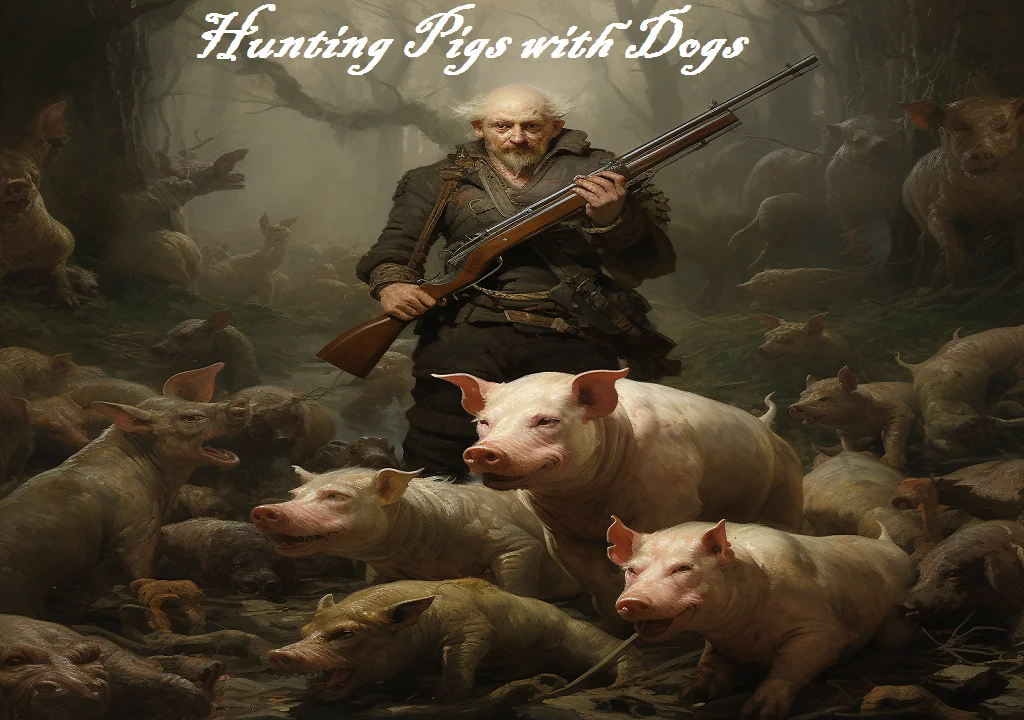Hunting Pigs with Dogs: An In-depth Exploration

Table of Contents
- Table of contents
- 1. The Historical Connection
- 2. The Dogs: Breeds & Training
- 3. The Hunt: Techniques & Tactics
- 4. Ethical Considerations
- 5. The Challenges of the Hunt
- 6. Gear and Equipment
- 7. The Cultural Significance
- 8. Controversies & Criticisms
- 9. The Future of Pig Hunting with Dogs
- 10. Personal Stories & Anecdotes
- Conclusion
- FAQs
Table of contents
1. The Historical Connection
- The Ancient Sport: Before modern conveniences, cohorts relied on hunting pigs with dogs for sustenance and community bonding, using rudimentary tools and rudimentary dog breeds.
- Evolving Tradition: As societies changed, so did hunting methods. From survival to sport, the evolution reflects changing societal norms and needs.
- Geographical Spread: Originating perhaps in Europe or Asia, this method spread globally, adapting to local cultures and terrains.
2. The Dogs: Breeds & Training
- Breeds: The Catahoula and Bull Arab are favorites, but breeds like the Bay dog and Pitbulls have been historically involved too, chosen for their stamina, strength, and natural hunting instincts.
- Training Regimens: Starting as puppies, these dogs undergo rigorous training. From basic obedience to tracking and holding, every step is crucial.
- Safety and Care: Beyond training, ensuring a dog’s health, regular vaccinations, and proper diet is essential for its performance and well-being.
3. The Hunt: Techniques & Tactics
- The Tracking Stage: Dogs are first released to pick up on the pig’s scent, a process that can take hours or even days.
- The Bail and Hold: While one set of dogs “bails” the pig—keeping it cornered—another might be dispatched to hold the pig, preventing escape.
- Hunter’s Role: Beyond tracking, hunters must also ensure safety, make on-spot decisions, and usually perform the final catch or kill.
4. Ethical Considerations
- Animal Welfare Concerns: Detractors argue that the method can cause undue stress to both pigs and dogs, leading to potential injury or death.
- Conservation Efforts: In places like Hawaii, wild pigs harm native ecosystems, and hunting is a method of control.
- Balancing Act: How does one weigh the thrill and tradition of the hunt against the undeniable ethics of animal welfare?
5. The Challenges of the Hunt
- Terrain and Climate: From the muggy forests of the American South to Australia’s arid outback, hunting techniques adapt to local conditions.
- Pig Behavior: Wild pigs are smart and can be aggressive. Their unpredictable nature adds to the challenge.
- Dog Safety: From snake bites to aggressive pigs, myriad dangers lurk. Proper training and protective gear are vital.
6. Gear and Equipment
- Protective Gear for Dogs: Modern kevlar vests, protective collars, and boots shield dogs from tusks and rough terrains.
- Hunter’s Arsenal: From knives to firearms, hunters have a range of tools. The choice often depends on local regulations and personal preferences.
- Tracking Tools: GPS collars and drones have revolutionized the hunt, ensuring both efficiency and safety.
7. The Cultural Significance
- Ceremonial Hunts: In many cultures, a successful hunt signals the transition from boyhood to manhood.
- Community and Camaraderie: The hunts foster deep bonds among participants, creating stories that are retold for generations.
- Literature and Folklore: From Homer’s “Odyssey” to indigenous tales, these hunts have always captured human imagination.
8. Controversies & Criticisms
- Animal Rights Perspective: Many believe hunting for sport, especially using dogs, is cruel and outdated.
- Hunter’s Perspective: Proponents argue about tradition, conservation, and the deep respect they have for both the dogs and the wild pigs.
- Finding Common Ground: Sustainable hunting methods, like ensuring a quick end for the pig, might be a middle ground.
9. The Future of Pig Hunting with Dogs
- Modern Adaptations: With technology and changing societal norms, how will this age-old practice evolve?
- Conservation Efforts: With growing pig populations in certain areas, the practice might see a resurgence—but with more ethical considerations.
- Community Engagement: Workshops and training programs can help ensure a new generation of ethical, informed hunters.
10. Personal Stories & Anecdotes
- Close Calls: Veteran hunters share tales of hunts that went awry, teaching lessons to novices.
- Dog Heroes: Celebrating dogs that have shown extraordinary courage or intelligence during a hunt.
- The Bond: Heartwarming tales that underscore the inseparable bond between a hunter and his canine companion.
Conclusion
Pig hunting with dogs is a complex tapestry of tradition, sport, ethics, and survival. While the future is uncertain, what remains is the undeniable connection between humans, dogs, and the wild.
FAQs
- Why not use traps or snares?
Ans. Traps can be non-selective and may lead to the unintentional capture of non-target animals. - How long has this method been around?
Ans. For thousands of years, differing based on region and culture. - How do hunters ensure their dogs’ safety during the hunt?
Ans. Training, protective gear, and constant vigilance. - Is there a specific season for pig hunting?
Ans. This varies by region. Some places have designated seasons, while others allow it year-round due to overpopulation. - Do all hunters eat the pigs they catch?
Ans. Many do, viewing it as a sustainable food source and respecting the animal by using as much of it as possible.
With this in-depth exploration, we’ve journeyed through history, across terrains, and into the heart of the hunt itself. As with many traditions, its future lies in the balance between respect, evolution, and ethics.







